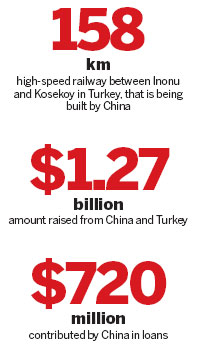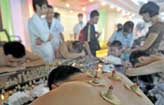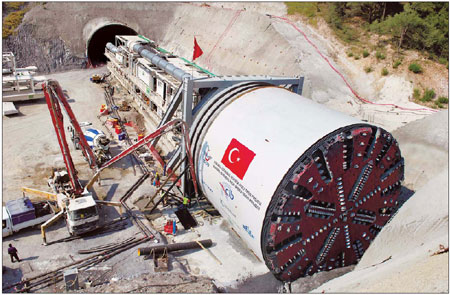Top News
High-speed rail will set the pace in Turkey
Updated: 2011-07-13 07:34
By Zhang Haizhou (China Daily)
|
|
Project serves as springboard to enter European market, reports Zhang Haizhou in Ankara.
It was noontime and the temperature was more than 30 C on this typical summer day in Pamukova, in mountainous west Turkey.
 |
"We have everything ready," he said as he scratched his forehead. "If the Turks can hand over the finished groundwork we can lay the tracks quickly and do the other work to wrap up this project."
The project is a 158-km high-speed railway (HSR) between Inonu and Kosekoy, Phase 2 of a prospective 533-km Ankara-Istanbul line.
Expected running speed on the new line will be 250 km/h.
As high-speed rail develops rapidly in China, the country is working hard to sell its technology and products to Europe.
News reports have mentioned China's ambitions to have its high-speed rail operating in European countries, including the United Kingdom, Bulgaria and Hungary.
But the project Wu and his colleagues, from the China Civil Engineering Construction Corp, are building in Turkey remains the only Chinese HSR project in Europe.
(Turkey's economy is counted as European, and ranked sixth, as the country seeks membership in the European Union. Geographically, about 97 percent of Turkey lies in Asia and the 3 percent in the extreme northwest in Europe.)

Construction began in October 2008, and plans call for the line to open by December 2013.
"We now have 35,000 tons of steel track, bought from Italy, ready for the project. All other equipment is almost ready, too," said Wu, who's the chief engineer in charge of laying all the tracks.
On Monday, the first batch of equipment from China was unloaded at Istanbul's Haydarpasa port. It included two 117-ton freight locomotives and a special ballast-roller.
Two Turkish companies, in partnership with China Civil Engineering, are doing the groundwork. In mountainous Turkey, Wu and his colleagues have frankly expressed their concern that the work may be delayed.
The terrain poses the biggest difficulty, said Zheng Jianbing, senior engineer and assistant president of China Civil Engineering. "Phase 2 is the most difficult part of the Ankara-Istanbul HSR."
Although the project is just 158 km long, 55 km of it involves tunnels and 10 km is bridges. The longest tunnel is 6.1 km, the longest bridge 1.96 km. The highest part of the project is more than 800 meters above sea level, the lowest about 20 meters.
"More surveys than expected need to be done during the course of the construction due to the difficult terrain. The influence on the progress is quite big," Zheng said.
E-paper

Ringing success
Domestic firms make hay as shopping spree by middle class consumers keeps cash registers ringing in Nanjing
Mixed Results
Crowning achievement
Living happily ever after
Specials

Ciao, Yao
Yao Ming announced his retirement from basketball, staging an emotional end to a glorious career.

Going the distance
British fitness coach comes to terms with tragedy through life changes

Turning up the heat
Traditional Chinese medicine using moxa, or mugwort herb, is once again becoming fashionable

